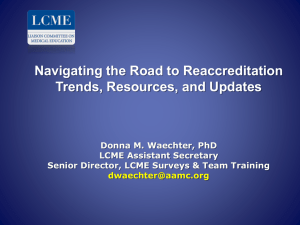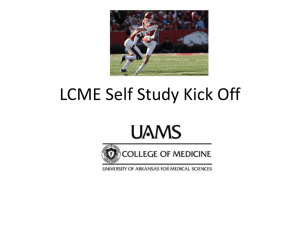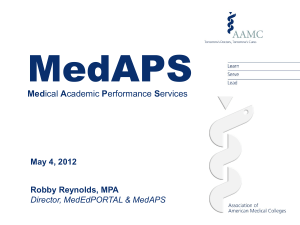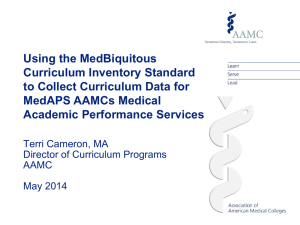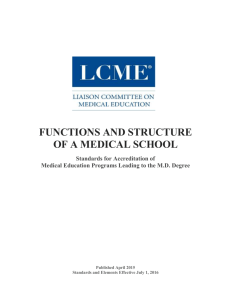Executive Summary
advertisement
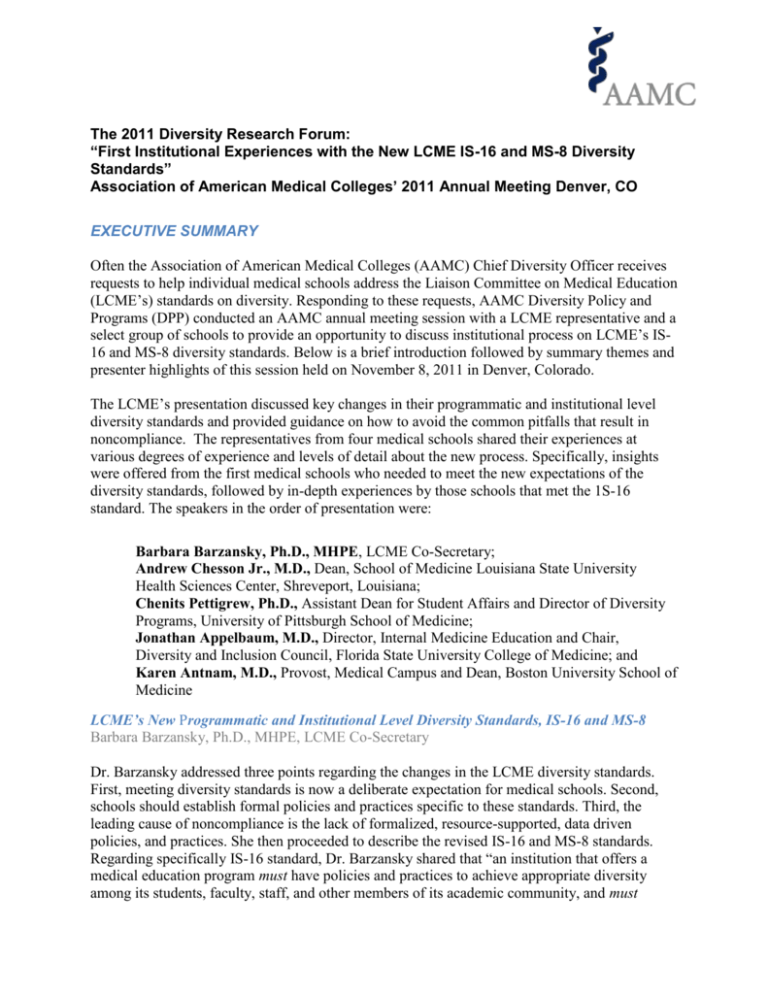
The 2011 Diversity Research Forum: “First Institutional Experiences with the New LCME IS-16 and MS-8 Diversity Standards” Association of American Medical Colleges’ 2011 Annual Meeting Denver, CO EXECUTIVE SUMMARY Often the Association of American Medical Colleges (AAMC) Chief Diversity Officer receives requests to help individual medical schools address the Liaison Committee on Medical Education (LCME’s) standards on diversity. Responding to these requests, AAMC Diversity Policy and Programs (DPP) conducted an AAMC annual meeting session with a LCME representative and a select group of schools to provide an opportunity to discuss institutional process on LCME’s IS16 and MS-8 diversity standards. Below is a brief introduction followed by summary themes and presenter highlights of this session held on November 8, 2011 in Denver, Colorado. The LCME’s presentation discussed key changes in their programmatic and institutional level diversity standards and provided guidance on how to avoid the common pitfalls that result in noncompliance. The representatives from four medical schools shared their experiences at various degrees of experience and levels of detail about the new process. Specifically, insights were offered from the first medical schools who needed to meet the new expectations of the diversity standards, followed by in-depth experiences by those schools that met the 1S-16 standard. The speakers in the order of presentation were: Barbara Barzansky, Ph.D., MHPE, LCME Co-Secretary; Andrew Chesson Jr., M.D., Dean, School of Medicine Louisiana State University Health Sciences Center, Shreveport, Louisiana; Chenits Pettigrew, Ph.D., Assistant Dean for Student Affairs and Director of Diversity Programs, University of Pittsburgh School of Medicine; Jonathan Appelbaum, M.D., Director, Internal Medicine Education and Chair, Diversity and Inclusion Council, Florida State University College of Medicine; and Karen Antnam, M.D., Provost, Medical Campus and Dean, Boston University School of Medicine LCME’s New Programmatic and Institutional Level Diversity Standards, IS-16 and MS-8 Barbara Barzansky, Ph.D., MHPE, LCME Co-Secretary Dr. Barzansky addressed three points regarding the changes in the LCME diversity standards. First, meeting diversity standards is now a deliberate expectation for medical schools. Second, schools should establish formal policies and practices specific to these standards. Third, the leading cause of noncompliance is the lack of formalized, resource-supported, data driven policies, and practices. She then proceeded to describe the revised IS-16 and MS-8 standards. Regarding specifically IS-16 standard, Dr. Barzansky shared that “an institution that offers a medical education program must have policies and practices to achieve appropriate diversity among its students, faculty, staff, and other members of its academic community, and must engage in ongoing, systematic, and focused efforts to attract and retain students, faculty, staff, and others from demographically diverse backgrounds.” MS-8 on the other hand means “a medical education program must develop programs or partnerships aimed at broadening diversity among qualified applicants for medical school admission.” Afterwards, she explained the three major areas of noncompliance: 1) Not having a formal diversity policy, preferably, at the medical school level or at the university level Dr. Barzansky informed the forum audience that institutions often fail to digest diversity in the medical school’s or the university’s policies. In other words, a formalized policy must be in place at one of these levels. 2) Lack of “value added” categories for students, faculty, and staff A second major area of noncompliance is the failure to define the specific areas in which students, faculty, and staff will “add value” toward learning. This means schools should avoid a long list of ambiguous target areas. Rather, schools must be explicit about what is being done in the learning environment with regard to these groups and how these actions match the institution’s goals. 3) Lack of documentation of existing programs to enhance diversity and resources to support them The third area of noncompliance is a school’s failure to document the programs that offer more variety and also demonstrate that there are available resources. In other words, a stated action around diversity must have a formal budget. FOUR MEDICAL SCHOOL EXPERIENCES WITH THE LCME DIVERSITY STANDARDS The next section of the forum targeted the experiences of the four schools. Based on their lessons learned, each school provided an overall or in-depth account of the steps they took to meet the new diversity standards. One School’s Overall Experience and Processes that Led to Partial Success Followed by its Next Steps Andrew Chesson Jr., M.D., Dean, School of Medicine Louisiana State University (LSU) Health Sciences Center, Shreveport, Louisiana Dr. Chesson explained that the School of Medicine (SOM) at the LSU Health Sciences Center in Shreveport, Louisiana moved forward to “partially” meeting the new standards based on various historical, political and administrative actions. He noted that as the region’s second statesupported medical school, admission is only available to Louisiana residents because of the region’s community and political commitment to expand the local healthcare workforce. Beyond the residency restriction for admission to the school, he noted that the race-neutral admissions approach set forth by Hopwood (U.S. 5th Circuit Court, 1996) and the affects of hurricane Katrina are challenges toward increasing diversity for both the student and faculty. AAMC DPP 2011 Diversity Research Forum 2 Dr. Chesson shared the details of the school’s attempts to meet the LCME’s diversity standards that occurred between 2007 and 2011. He noted that their process always involved a rehearsal in preparation for the LCME meeting. In 2007, the school’s report to LCME stated that it experienced recruitment challenges due to Katrina. The school reported on actions around diversity that included its variety of initiatives and faculty recruitment. These actions were supported by data that showed a modest outcome. LCME responded that student recruitment needed to be addressed and that due to the natural disaster; a report of the SOM’s financial stability was needed to show how the school would stabilize certain pipeline programs. In 2009 the school submitted a progress report to LCME highlighting its partnership program to grow the science education pipeline and that there were no negative financial impacts due to the natural disaster. Dr. Chesson explained that LCME’s response to their 2009 report directed the school to further address medical student diversity and classified the progress for this population as “in transition” An update was required in 2011. Dr. Chesson informed that the 2011 report to LCME highlighted four specific tactics to meet LCME expectations. First, they filled a key administrative position in the Diversity Affairs/Equal Employment Opportunity office. Second, the SOM’s integrated the Road Map to Diversity guidelines and demonstrated participation in the AAMC’s Holistic Review Program. Third, they expanded the AHEC program. Fourth, they stood up the LSU’s System Diversity Task Force to address campus climate, student diversity, and workforce training needs. LCME responded that this report showed that the school “partially resolved” its student diversity deficits and that a report was due in 2012-2013 to show that it met the “intended results.” Dr. Chesson completed his presentation with two questions about LCME’s 2011 requests. First, what does the LCME mean by “intended” results and what are examples of achieving these aims? Second, how does an institution resolve the apparent conflict between LCME’s accreditation expectations and the SOM’s diversity goals as outlined by the state legislature and budget office? An Experience Early in the Process Chenits Pettigrew, Ph.D., Assistant Dean for Student Affairs and Director of Diversity Programs, University of Pittsburgh School of Medicine Dr. Pettigrew outlined how the success if the University of Pittsburgh School of Medicine’s was influenced by envisioning MS-8 and IS-16 working together. He explained that the school drew on its foundational and historical efforts that increased student and faculty diversity and actions to eliminate discrimination. These experiences helped the school provide activities it would report to the LCME that AAMC’s Group on Diversity and Inclusion (GDI)’s definition used to anchor their school’s actions. The report included their plans to align key players around their diversity efforts such as the physician inclusion council that includes chairpersons by specialty, the senior associate vice chancellor, faculty, and residents. Dr. Pettigrew continued that Pittsburgh SOM’s report explained how the diversity definition was used to guide perception and to collect associated surveillance data. The data collected was used to strategically realign the school’s actions (e.g. student recruitment and retention). He summarized their process that allowed for successful reaccreditation through 2019 in the following four points: a) have a framework; b) identify and share a definition of diversity with key players; c) keep diversity as a high priority, and d) look back to give direction for the future. AAMC DPP 2011 Diversity Research Forum 3 LCME’s response to their report noted their success for students but required that the school address faculty, house staff, and staff diversity. Dr. Pettigrew noted that their current actions involve developing a response and realignment strategy to address these challenges. Two In-Depth Examples of Meeting the IS-16 Standard Jonathan Appelbaum, M.D., Director, Internal Medicine Education and Chair, Diversity and Inclusion Council, Florida State University College of Medicine Dr. Appelbaum provided an in-depth look at how Florida State University (FSU) College of Medicine (COM) met its IS-16 standard. He explained that their reports to the LCME started with using the SOM’s mission to identify the populations it served: elder, rural, minority, and the underserved. Dr. Appelbaum noted that this direct link to the school’s mission statement helped simplify their initial experience with the LCME in 2005 and again in 2011. The report in 2011 from the LCME noted the strength of their pipeline programs. The elements that contributed to their success included disaggregating student, faculty, and staff data by race and ethnicity. Dr. Appelbaum noted that the school fulfills its mission related to IS-16 through pipeline programs, holistic admissions, student support systems, trainings in the community setting, and one-on-one instruction by community physicians. In particular, their pipeline program included specific trainings and data collection concerning their progress regarding on-going services between students’ middle school and clinical years. The report also noted the school’s efforts to conduct and track outreach and advising activities. The progress of the pipeline programs were captured through data collection that included numbers and percentages of participants and graduates that were separated by background, specialty, track, and location of practice (e.g., rural). Boston University School of Medicine Karen Antnam, M.D., Provost, Medical Campus and Dean, Boston University School of Medicine Dr. Karen Antnam shared that the Boston University (BU) School of Medicine’s success at meeting IS-16 began with BU has a statement on diversity which is outlined in the faculty search manual. At the medical school, diversity is an integral part of the mission statement, strategic goals, and institutional learning objectives. She noted that in addition to the school’s history of inclusiveness towards all gender, religions, races, and national origins, there are seven areas of activities where the school addresses diversity: 1) recruitment, 2) coordination, 3) admissions, 4) pipeline programs, 5) financial aid, 6) the curriculum, and 7) community engagement. Dr. Antnam further explained that the medical school’s recruitment strategy is stated in a manual where diversity and excellence are twins aim thus deliberating steering clear of unconscious bias. The school reported on its coordination efforts that formed a campus-wide Committee on Diversity and Health Disparities and an Office of Diversity and Multicultural Affairs. AAMC DPP 2011 Diversity Research Forum 4 Actions to increase diversity are noted in the admissions process of the schools mission. A holistic review process is re-enforced by a trained faculty committee as they select applicants. In addition, the school reported on the type, duration, and target populations of the pipeline programs. Dr. Antnam also noted the report of their financial aid activities to enhance diversity involved allocating funds based on need. The school’s curriculum changes to address diversity were described in the report by stressing the content, exercises, and format of the sessions. Finally, Dr. Antnam explained that the BU SOM reported its community engagement actions include its relationships with community health centers, efforts to address health disparities through clinical trials that target community members and the availability of pipeline programs for public school children. THEMES FROM THE FACILITATED DISCUSSION Following the presentations a moderated discussion followed between presenters and the audience. Below are three key summary themes on how to address various challenges associated with MS-8 and IS-16 standard. Set your school’s diversity goals and report outcome data on how they were met The LCME views data as an indicator of the extent to which a school met the goals it set for itself. This means reporting the progress made for the population it values. For example, if a pipeline program starts in college then the data collected should track the students through enrollment into medical school. Use the holistic review approach and electronic voting devices to facilitate equity in admissions and in the classroom The holistic review process can make certain that both minorities and non-minorities benefit from diversity efforts. Also, electronic voting devices can encourage participation by a wide range of diverse identities in the classroom. Explore using definitions of diversity that cut across multiple systems Schools must take steps to ensure that its definition of diversity accounts for global, system, and legal considerations. For example, one school combined information from the AAMC professional group on Diversity and Inclusion (GDI), the school’s local circumstance, and other environmental factors to outline its definition of diversity. Next Steps and the LCME The AAMC will explore with the LCME the development of a website to support medical schools throughout the accreditation process. This website would provide guidance on best practices and how to address the common challenges schools experience throughout the process. AAMC DPP 2011 Diversity Research Forum 5 AAMC DPP 2011 Diversity Research Forum 6
